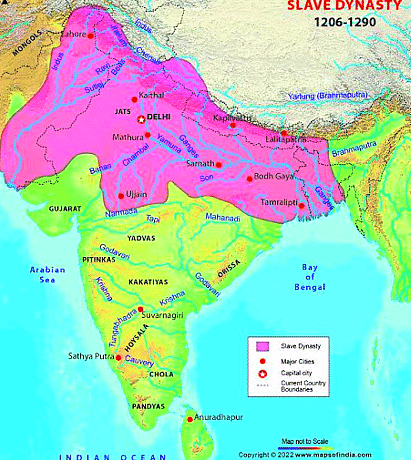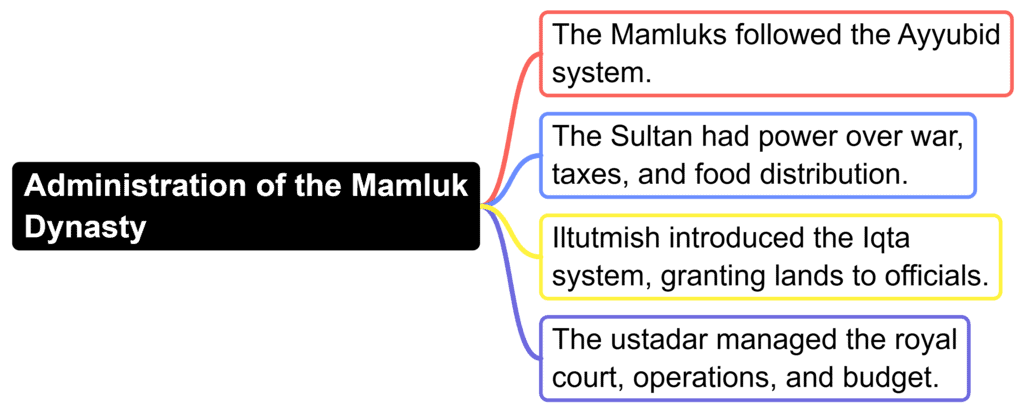UPSC Exam > UPSC Notes > History for UPSC CSE > The Slave Dynasty: The Delhi Sultanate
The Slave Dynasty: The Delhi Sultanate | History for UPSC CSE PDF Download
| Table of contents |

|
| Background of the Mamluk Dynasty |

|
| Important Rulers of the Mamluk Dynasty |

|
| Administration of the Mamluk Dynasty |

|
| Decline of the Mamluk Dynasty |

|
Background of the Mamluk Dynasty
- Meaning and Origin: Mamluk means "owned" and refers to a prominent military aristocracy developed in the Islamic Empire of the Abbasid Caliphate in the 9th century AD. Despite being slaves, Mamluks were highly valued by their masters.

- Qutb-ud-din Aibak: The first ruler of the Mamluk Dynasty, reigning from 1206 to 1210.
- Iltutmish: Succeeded Aibak and ruled from 1211 to 1236, establishing a strong kingdom.
- Ghiyas-ud-din Balban: The last effective ruler, governing from 1266 to 1286, known for his attention to governance and military strength.

Important Rulers of the Mamluk Dynasty
Qutb-ud-Din Aibak (1206-1210 AD)- Background: Aibak was an Indian general in the Ghurid army, living from 1150 to 1210 CE.
- Rise to Power: After Muhammad Ghori's death in 1206, Aibak fought for control of Ghurid territories in northwestern India.
- Challenges and Achievements: Faced numerous revolts by Rajputs and other Indian chiefs. Commissioned the Delhi Qutb Minar and the Ajmer Adhai Din Ka Jhonpra.
- Succession: Succeeded by Aram Shah and later by his son-in-law Iltutmish.
Iltutmish (1211-1236 AD)
- Early Life: Initially a slave purchased by Qutb-ud-din Aibak, Iltutmish rose to prominence, becoming amir-e-shikar and later governor of Gwalior and Baran.
- Accession: Defeated Aram Shah in 1211 to become Sultan.
- Contributions: Completed the Qutb Minar and built the Sultan Ghari funerary monument. His tomb is in Mehrauli's Qutub complex.
Razia Sultana (1236-1240 AD)
- Background: Daughter of Iltutmish, born to a Turkic slave.
- Reign: The first and last woman to occupy the throne of Delhi among Muslims and Hindus.
- Achievements: Known for her archery and horse riding skills. Managed Delhi during her father's military campaigns.
Ghiyas-ud-din Balban (1266-1287 AD)
- Early Life: Born into a Turkish family, sold as a slave, and impressed Iltutmish with his talent.
- Career: Held various positions including Amir-i-Shikar under Raziya Sultana. Played a significant role in the political landscape of Delhi, including the deposition of Raziya and the ascension of Nasir-ud-din Mahmud.
- Governance: Focused on strengthening the military and administration.
Administration of the Mamluk Dynasty

Decline of the Mamluk Dynasty
- Last Sultan: Muiz-ud-din Muhammad Qaiqabad, the last Mamluk Sultan, ruled from 1287 to 1290. His reign was marked by neglect and disorganization.
- Weak Leadership: Frequent Mongol invasions and internal strife weakened the dynasty.
- End of Dynasty: The Mamluk dynasty ended with Qaiqabad's death, succeeded by the Khilji dynasty under Jalal ud din Firuz Khalji.
Conclusion
- Foundation: Qutb-ud-din Aibak is regarded as the true founder of Turkish rule in India.
- Prominent Rulers: Among the 10 monarchs of the Mamluk dynasty, Qutb-ud-din Aibak, Iltutmish, and Ghiyas-ud-din Balban are considered the greatest Sultans.
- Legacy: The achievements of these Sultans elevated the significance of the Delhi Sultanate. The dynasty was ultimately overtaken by the Khilji dynasty.
The document The Slave Dynasty: The Delhi Sultanate | History for UPSC CSE is a part of the UPSC Course History for UPSC CSE.
All you need of UPSC at this link: UPSC
|
210 videos|855 docs|219 tests
|
FAQs on The Slave Dynasty: The Delhi Sultanate - History for UPSC CSE
| 1. Who were the rulers of the Slave Dynasty in the Delhi Sultanate? |  |
Ans. The rulers of the Slave Dynasty in the Delhi Sultanate were Qutb-ud-din Aibak, Iltutmish, Raziya Sultan, and Nasiruddin Mahmud.
| 2. What is the significance of the Slave Dynasty in the history of Delhi Sultanate? |  |
Ans. The Slave Dynasty was the first Muslim dynasty to rule over the Delhi Sultanate, marking the beginning of Muslim rule in the Indian subcontinent. It laid the foundation for future dynasties and established the administrative and political structure of the Delhi Sultanate.
| 3. How did the Slave Dynasty come into power in the Delhi Sultanate? |  |
Ans. The Slave Dynasty came into power in the Delhi Sultanate after Qutb-ud-din Aibak, a former slave of Muhammad of Ghor, established his rule in Delhi in 1206 CE. Aibak's military success and his position as the governor of Delhi paved the way for the Slave Dynasty's rise to power.
| 4. Who was the first female ruler of the Delhi Sultanate during the Slave Dynasty? |  |
Ans. Raziya Sultan was the first and only female ruler of the Delhi Sultanate during the Slave Dynasty. She ascended to the throne after the death of her father, Iltutmish, and ruled from 1236 to 1240 CE.
| 5. What were the major achievements of the Slave Dynasty in the Delhi Sultanate? |  |
Ans. The major achievements of the Slave Dynasty in the Delhi Sultanate include the establishment of a strong administrative system, the introduction of the Iqta system for revenue collection, the construction of important architectural structures like the Qutub Minar, and the expansion of the Delhi Sultanate's territory through successful military campaigns.
Related Searches





















